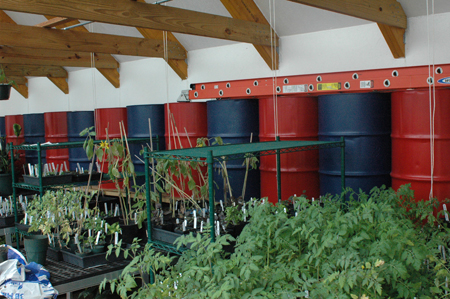By: Carrie Gonnella, 2011 EDF Climate Corps Public Sector Fellow
This summer I am lucky to have a fellowship at Catawba College‘s Center for the Environment. I was fortunate to start just in time to learn about two initiatives the Center is pursuing: a green roof for the science building and a new high efficiency greenhouse.

I learned all about green roofs from Chuck Friedrich of Stalite Co. Stalite makes a green roof growing medium that is durable, lightweight, and easy to apply. There are many important steps involved in creating a luscious, healthy, and sustainable living roof, and Chuck gave us many things to consider, including:
- There are two green roof options: extensive or intensive. An extensive roof has 2-4 inches of growing material, supporting sedum and other low-lying foliage. Intensive is 6 inches or more, and can support a greater range of plants, including trees.
- Why remain flat? Subtle rolling hills can be created on green roofs based on the location of roof ballasts. They can support a thicker growing medium.
- A green roof can extend the life of your roof by threefold!
Next, I learned all about high efficiency greenhouses from Dr. Terry Carroll of SunCatcher Design Group. Traditional greenhouses can get too hot in the summer for optimal growing and require heating from fossil fuels in the winter. SunCatcher strives for a zero carbon operating greenhouse, enabling year round growing without the expense and GHG emissions of winter heating. Terry showed us how a greenhouse SunCatcher is designed, and I learned these interesting tidbits from his presentation:
- Optimal solar heating results from an east-west axis and a 60 degree angle on the south facing side of the building.
- Large water-filled metal drums on the north wall inside the greenhouse collect and store heat from solar energy entering the greenhouse windows. These drums then release that heat back into the greenhouse to keep the temperature steady, day and night, through summer and winter.
- SunCatcher originally painted the metal drums black in order to absorb the most solar energy. However, through testing they determined that alternating red and blue painted drums reflects light wavelengths that plants just love.
All in all, I had two fascinating presentations in my first week that made me dream about the green roof I want someday, and the luscious vegetables I’ll grow year round in my zero carbon greenhouse! For now, I’ll settle for keeping abreast of what Catawba is doing. It’s exciting to be working at a college committed to exploring all routes to sustainability.
EDF Climate Corps Public Sector (CCPS) trains graduate students to identify energy efficiency savings in colleges, universities, local governments and houses of worship. The program focuses on partnerships with minority serving institutions and diverse communities. Apply as a CCPS fellow, read our blog posts and follow us on Twitter to get regular updates about this program.
 Editor’s Note: This column comes from Environmental Defense Fund. Author credit goes to Carrie Gonnella.
Editor’s Note: This column comes from Environmental Defense Fund. Author credit goes to Carrie Gonnella.